|
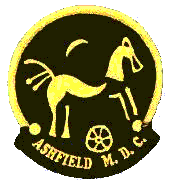

| |
A Detector's Dozen On A Club Search, Just Before The Off
 |
From left to right:- Eric Purseglove, Mark Attenborough, Mick Peel,
Roger Bacon (kneeling), David Rhodes, Jeff Islip, Dennis Brown,
Bill French, John Radford, John Wardle, Norman Daynes and Barry Goldsmith.
|
Spur
|

This beautiful example of a spur was found by John Radford during a club search.
The find site, near Newark, had been involved in the Civil War siege.
The spur was awarded the Find of the Month for May, 2006.
|
Weil's Disease
|
|
On a recent Sunday an American woman took with her, on a short boat trip, some cans of Cola.
She placed these in the boat’s refrigerator. On the Monday she was rushed ashore and into an
Intensive Care Unit. Sadly on Wednesday she died, the post mortem revealed that she had died of
Leptospirosis also called, Weil’s Disease, Pea Picker’s Disease and Infectious Jaundice
|

European Rat |
|
The subsequent investigation concluded that the disease had been contracted by her drinking
out of a Cola can without washing the can before drinking the contents. The Cola cans had
traces of dried rat urine on them containing Weil’s Disease and other toxic substances
harmful to humans. It was thought that the contamination occurred while the Coala cans were
being stored prior to distribution to retailers. In the American enquiry into the death
of the unfortunate woman it was found that the tops of drink cans and crown corked bottles
had more germs and bacteria than found in public toilets.
Leptospires can be excreted by rodents and certain domesticated animals in their urine.
The infection can live for several weeks in a moist state and an indeterminate time in dried
urine. Infection is by contact with urine of infected animals or food and water that has
been contaminated. Leptospires can enter the human body by the nose or eye. Although it is
thought that they cannot penetrate through intact skin any small cut or abrasion
gains them ready access. The death rate is about 30 percent of severely ill and jaundiced patients.
It is essential that the tops of drink cans and crown corked bottles be washed and,
if possible, a glass be used to drink from. Apart from the risk from cans and bottles
the metal detectorist is exposed to the disease just by being on a field and handling
the soil and vegetation when digging. This risk can be minimised by wearing gloves
whilst detecting and by using disposable anti-bacterial wipes before eating or drinking.
(Based on a Readers’ Letter, May, 2006 issue of Treasure Hunting Magazine)
|
Hide and Seek
|
|
From time to time metal detectorists are asked to find articles lost by farmers
and members of the general public. Recently two such requests were made to the club.
The first was to search a large garden of a bungalow being prepared for sale. The owner
of the bungalow was suffering from dementia and had to go into a nursing home.
Before going into the home she had told her son that she had buried coins in the garden
but could not remember the exact location.
A search by Mark Attenborough and John Gough failed to find anything of interest but part
of the garden, the most likely hiding place, for the coins was unsearchable. Set into the
bungalow walls, under the front windows and just above ground level, were five large zinc
alloy air grills making the detection of any metal within eighteen inches, other than the
air grills, impossible.
The son was informed of this and decided that that he would use a spade to search
the undetected areas, however it is not known if he has discovered anything.
The second request was from a farmer who allowed the club to detect on his land, he asked
for a metal detector search to be made for a hypodermic syringe needle that had been lost
when a vet had to put a horse down on his farm. Jeff Oscroft visited the farm with his
detector but found on arrival that the needle had been found by a fingertip search. (Ouch!).
Searches like these, even if unsuccessful, can only be good for public relations and could
be possible sources of new detecting land for the club.
|
Meet The Members |

|
|

|
David Rhodes
Dave, an ex-miner, joined the Ashfield Club in 2002.
He uses a Minelab Explorer 11 metal detector.
|
|
Richard Northey
Richard, a self employed plasterer, joined the Ashfield
Club in 2002. He also uses a Minelab Explorer 11.
|
Norman's Seal
|
|
The full story of Norman Daynes finding the Warburton seal, as published in the
June, 2006 issue of the Searcher magazine, can be read by clicking here.
|
Searching the Jurassic Coast by John Radford
|
|
So what does a detectorist do when on holiday? Well besides taking his
or her detector and searching the beaches or maybe finding a farm to find
the occasional gold Angel (sorry Barry!) I visited the early medieval port
of Lyme Regis on the Dorset coast, which is the site of many finds of Dinosaur
and other fossils. So I thought, well how about trying to find something a bit
older than the usual hammered coin?
A short trip to the nearby seaside village of Charmouth which is all but a walk
away from Lyme Regis and a visit to the Charmouth Fossils shop on the beach front
near the car park gave me all the information I needed to know. They are very helpful
and give guided two-hour fossil hunting expeditions along the shoreline below the cliffs
of Charmouth at a cost of £7 for adults and £3 for children. You can also hire the
“chipping hammers” from this shop for £3 plus a returnable deposit of £10. The
“chipping hammers” are basically a hammer with a chisel point with which you break
open the soft rock, hopefully to reveal a fossil inside. If you do find a fossil,
they need to be carefully cleaned up and dressed in order to appreciate them at their best.
The Fossil shop can do this for you.
Inside the shop are hundreds of fossils, some to buy and some on exhibit, one such fossil
is the head part of an Icthyosaur, found at Charmouth Easter 2000. It has been given
the name Mary, the head is around two metres long with huge eye sockets and a two
great rows of teeth, I wouldn’t want to meet that on a dark night or anytime for
that matter!
For those members who have access to the internet, visit
charmouthfossils.co.uk and
view the story of finding Mary which also gives many interesting photographs of the
fossil. If you do not have a computer, many libraries now have free internet access
for library users and have assistants who can show you how to go on. I think the
photographs on the site are copyright, so to give you a clue, I have done a drawing
of the Icthyosaur fossil head.
So, how did I get on I hear you ask. Where are all the fossils you found? Well I
arrived too late for the guided walk so, armed with the information I needed I set
out on my own in the hot sun to search for a fossil or two. It is a matter of
experience of choosing the right rock to chip away at and if you look along the
shore, you can see the rocks that have hammer marks on them made by other searchers.
So following their lead is a good way of doing it (Looking for hammereds again!)
Among the fossils that may be found in the rock are ammonites, which have a ribbed
spiral type shell and date back 240 million years ago, also the fossils of belemites,
which are squid like creatures from over 190 million years ago are often found on the
beach. They look a bit like long transparent bullets.
The type of rock in which the fossils are found are often surrounded by thick grey
slate/clay like mud which does nothing to enhance the appearance of your sandals or
your fresh clean white T shirt so I soon found that appropriate clothing is advisable.
I quickly found that fossil hunting can be quite dangerous and the need to be very
aware of cliff falls and being cut of by tides.
Having spent about an hour in the baking sun, searching what reminded me of a colliery
pit tip which I used to play on when a lot younger, I found that there must be a knack
to finding a discarded Dinosaur. All I had for my efforts was a small indistinct
impression in a rock of an ammonite. Perhaps all the fossils had been found that day
or were sitting in the shop. So I wandered back along the shore and concentrated on looking
for the fossils of belemites amongst the pebbles. Here again, it seemed easier to find
hen’s teeth and seeing that hens are supposed to be distantly related to dinosaurs
then I suppose that’s what some of these fossils could well be!
I managed to find a small part of a belemite fossil so the day was not lost and all
things considered, an enjoyable beach walk. Better fossils can be found on the
beach after a storm, if you are interested. I think I’ll be sticking with metal detecting.
|

|
|
Icthyosaur Head
|
The Crimea, Sebastopol And Balaclava
|
|
On Monday, 3rd. of August, 2006, Richard Rutherford-Moore gave a talk to
club members about the Crimean war and the siege of Sebastopol. The charge
of the Light Brigade at Balaclava was gone into in detail and many of the
myths surrounding the battle were dispelled.
Richard is well qualified to talk about the subject, he is the military advisor
to the Sharpe and the Hornblower television series. He has also conducted
many groups on tours of the Crimea and other battle sites. This is the third
talk Richard has given to our club, the other talks were about Robin Hood and Sharpe.
An enjoyable evening was had by all and it is hoped that in the near future
Richard will again give us the benefit of his knowledge and expertise.
|

|
|
Mark Attenborough Richard Rutherford-Moore.
|
Finding a Patten |
|
John Gough |
In recent months the Ashfield Metal Detecting Club has taken on a number of
new members with varying experience of metal detecting. Some of these new
members will not know what a foot pattens is and, on finding one, may just
discard it as an annoying bit of rubbish. The following short article, will,
I hope help to explain what foot pattens were used for and their history.
A former member of the Ashfield club, who left through ill health, David Mattison
was clearing the cellar of 43, Annesley Road, Hucknall Torkard, Nottinghamshire,
when he found what appeared to be the wooden sole of a shoe fastened to an
iron ring. This was subsequently identified as a foot patten of a type thought
to have been in use from the 17th. century to the early 1900s.
|
 |
|
When the foot patten was found it was hidden away, almost inaccessible,
on one of the beams that formed the cellar roof. The beam supported the
wooden floor of the small rear living room and had nailed to its underside
the lathe and plaster roof of the cellar. The foot patten was discovered
because the lathe and plaster had fallen away exposing the beams in places,
even so, a clothes line prop had to be used to recover it. The hidden foot
patten was positioned against the outer wall and under the rear back
door of the house.
|
|
 |
|
A search of the entire cellar, with the aid of an
electric torch, failed to produce anything of significance.
There are recorded instances of foot pattens and shoes being found under floorboards
and behind fireplaces of old buildings being renovated or demolished. The reason
for placing them there is not known, possibly when a house was built to bring
good luck to its future occupants or to ward off some particular form of evil.
The Oxford English Dictionary defines a foot patten as :-
“ A kind of overshoe or sandal worn to raise the ordinary shoes out of the mud or
wet. Consisting since the 17th. century of a wooden sole secured to the foot
by a leather loop passing over the instep and mounted on an oval ring, or
similar device, by which the wearer is raised an inch or two from the ground ”
A far more romantic derivation, however, is associated with a story told by John Gay
in his Trivia, or The Art Of Walking The Streets Of London. He describes how Martha
or Patty, the daughter of a Lincolnshire farmer fell in love with the
village blacksmith. To save her shoes and feet from getting wet, when she
went to milk the cows, he invented a type of clog. This was a shoe mounted
on an iron ring which he called Patty after his sweetheart.
“ The patten now supports each frugal dame,
which from the blue eyed patty takes its name ”.
“ Good housewifes safe through the wet on clinking pattens tread ”.
John Gay, Trivia, 1716.
Unfortunately there appears to be no substance to this story and more likely
origins of the word Patten are :- French, PATIN (a high heeled shoe or skate)
from the Greek PATAIN (to walk), or, possibly from PATTE (paw).
|
 |
|
The earliest mention of pattens I can find is 1390 in The Registrar of the
Diocese of York, stating that, contrary to order pattens were being worn in
the church by the clergy. It would appear that the wearing of pattens in
church was frowned upon up until relatively modern times. A sign outside the
|
|
church at Hawkesbury in Gloucestershire, requested that all persons attending
church leave their dogs at home and women not to enter the church with their
pattens on. The sign would appear to date from the 18th. century. A church
sign at Stoke Albany, Northamptonshire required men to scrape their shoes
and women to take their pattens off before going into church. A board with
pegs to hang the foot pattens on accompanied the sign.
The desire to wear foot pattens in church by the clergy in 1390 would be to
distance their feet from the cold stone floor of the church. In more modern
times the same motive is described for Miss Branwell in the Bronte’s
house, “ She almost always went about the house in pattens from her
dread of catching cold, presumably from the flagstone floors ”.
Owing to the practice of depositing all manner of slops directly into the
street in towns, it may be that the foot patten served another purpose as
remarked on by Randle Holme in 1688, “ What a patten is, your gentlewomen
will tell you, is a thing like a shoe sole with a strap above it to tie
over the shoe, having an iron at the bottom to raise the wearer thereof
from the dirt. By means whereof clean shoes may be preserved though they
go in foul streets ”. Evidence that foot pattens were worn by the better
off was given by Lady Newdigate in 1774 who when remarking on a visit to
Buxton said, “ The way to the well was almost impassable. We have been
forced to get high pattens and with them do exceedingly well ”.
In 1808 a Mr. Stedman invented a flat soled, hinged version of the patten
however in 1842 the India rubber Goloshoe or Galosh was patented and this
together with the improvement in road surfaces caused the demise of the
foot patten. The road surface improvement was pioneered by John London
McAdam, 1756 - 1836, who constructed road of crushed stone bound with
gravel and raised to improve drainage. In more recent times the addition
of tar to further bind the surface lead to the introduction to the
English language of the word Tarmacadam to describe such a road surface.
Various Acts of Parliament were passed for the paving of city roads,
examples were London in 1762 and Northampton in 1778.
Until 1827 shoes were designed straight this was to enable them to be worn
on either foot as the fancy took the wearer but after this date shoes
that would fit only the right or the left foot had generally replaced
the straight ones. An interesting entry in the Regimental Standing
Orders of the Shropshire Light Infantry dated 1800 was, “ Soldiers will
wear their boots on alternative feet on alternative days ” The foot patten found at Hucknall is for the right foot, this is evident due
to the shaping of the wooden platform to fit the contours of that foot.
This, the general design and the date of the house where it was found
may place it to rather late in the history of the foot patten and possibly
Victorian. By the 1850s the use of foot pattens had declined in towns,
they were now square toed, flat soled and fastened by velvet, patterned or
patent leather straps which matched the footwear. Although plain, iron
ringed foot pattens were in use in country areas and on washing days until
after the first world war.
I have been a metal detectorist for nearly thirty years and have only found
four foot pattens, unfortunately none of these have been in the same superb
condition as the one found by David Mattison. My finds were made during my
early detecting years and were rings of well rusted iron with no traces of
the wooden platform present. The use of fertilizer on the fields has hastened
the decay of most metal objects in the soil, this together with ability of
modern metal detectors to ignore the presence of ferrous metals will mean that
fewer foot pattens will be recovered in the future.
|
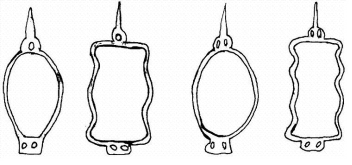 |
|
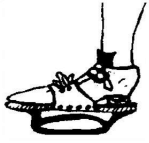 |
|
The rectangular pattens give a larger area in contact with the ground,
resulting in lower ground pressure. This effect is increased by the
fancy wavy design, which puts even more metal in contact with the ground.
|
|
A patten being worn over a shoe showing the height the metal ring
keeps the shoe away from the mud and dirt.
|
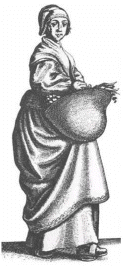 |
|
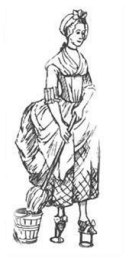 |
|
Countrywoman with shoes raised on pattens, entitled Debate Between Pride and Lowliness. 1640
|
|
Piety on Pattens
|
Two Foot Pattens Found On Ashfield Club Searches
|

|
Find Of The Month July 2006
|
| |
Coin |
|
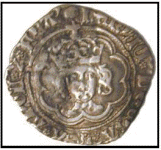 |
Henry VII Half Groat
1498 - 1499
Canterbury Mint
John Radford |
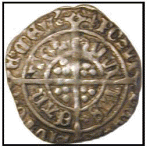 |
Artefact
|
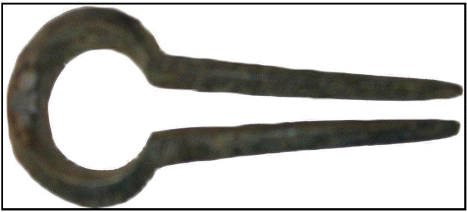 |
|
Jew's of Jaws Harp. Mary Severn
A Jew’s harp, Jaws harp or Jews trump is a small musical instrument
made of brass or iron its frame having the shape of a lyre. A flexible
strip of steel is attached to the larger end and is bent at a right angle
at the other end. (The metal tongue is missing from the one above, this is
usual with metal detector finds and caused by the steel rusting away).
Sound is produced by holding the frame between the teeth and tapping the bent
end of the steel tongue with the finger. Variations of the tone and sound
can be made by altering the size and shape of the mouth cavity.
|
Snap Time
|

|
|
On my way back from Newark, one lunchtime recently, I called in the Hearty Goodfellow
Public House in Southwell. On the wall I discovered this photograph of a farm worker
and his horse also having their meals but I bet mine was better!
|
Chatelaine
|
 |
Since medieval times a chatelaine has been worn by the lady of the
house (or Chatelaine) and sometimes by housekeepers. They were mounts of
metal with chains hanging from them, on the end of the chains were
small tools that may have been needed during the day, scissors, thimbles,
purse even keys to a tantalus or rooms that the servants could not access.
|
 |
|
The one on the left was found on a club search by John Wardle and may
have been silver plated. The one on the right is Victorian and made of
silver. This may have been given to a new bride by her husband or
mother-in-law as a wedding present. It was her badge of office and
announced to all that she was in charge.
|
US Army Called In To Save
Blackbeard's Pirate Ship
|
|
A team of U S Army conservators, using dredgers, are attempting to preserve
for future investigation the remains of the notorious pirate Blackbeard’s flag ship,
Queen Anne’s Revenge. The ship is lying in twenty-six feet of water off the
coast of North Carolina, where it ran aground and sank in 1718.
The wreck was discovered in 1996 but recently it was realised that the ocean
currents were stripping the protective layer of sand away and leaving it
open to damage. As Mark Wilde–Ransling, the archaeologist in charge of the
investigation of the shipwreck said, |
 |
|
‘We have reached a sand loss level
where artefacts may become exposed and deteriorate rapidly. We have so far
excavated less than ten per cent of the site and would like to get more up.’
The U S Army team will dredge sand from the sea bed and deposit it in the
form of a massive sand dune six feet high and six hundred feet long
alongside the wreck. It is intended that the sand will then be washed
over the remains by the currents and preserve it until a full excavation
can be made.
|
Blackbeard The Pirate
|
|
Edward Teach born in Bristol in 1680 was later to become the notorious
pirate, Blackbeard, who terrorised the Caribbean Sea from 1716 to 1718.
He was over six feet tall and fought wearing many knives, swords and
pistols. He weaved his long black beard with lengths of hemp and set
light to them making his appearance almost demonic and terrifying his
opponents. He served as a pirate with Benjamin Hornigold who made
Teach the captain of a captured French slave ship, La Concorde in 1717.
Teach renamed the ship Queen Anne’s Revenge. Captain Robert Maynard
of HMS Pearl was instructed to hunt down Blackbeard and on
November the 17th., 1718,
|
 |
came across the pirate in a North Carolina inlet. A chase ensued
resulting in Blackbeard’s ship running aground. Maynard and his crew
boarded and after a fierce fight in which Blackbeard was shot
five times and stabbed
|
 |
|
twenty times before he died. Maynard decapitated Blackbeard
and hung the head from the bowsprit of the Pearl for the voyage home.
Although Blackbeard’s reign of terror only lasted two years he amassed
tremendous amounts of treasure and booty. Most of this loot is thought
to be hidden in the banks of creeks and rivers in North Carolina.
False treasure maps exist to tempt the credulous into attempts to find
these buried riches but, as yet, nothing has come to light.
|
Medieval Clasp 1270 - 1450
|
|
Cast copper alloy folding strap clasp with sheet plate. The outer edge
of the frame has an integrally cast crowned head with four holes in the
crown. There is a raised transverse ridge on either side, level with the
chin of the head. The bar is narrowed and recessed for the folded sheet
plate which in turn is recessed for the frame. The plate is undecorated,
with a rivet hole at either end. One (that furthest from the frame)
contains a copper alloy rivet, the other holds an iron rivet ( possibly
this hole was enlarged-this appears to be a mend). Length total 61mm.
Width (buckle) 19.08mm. Thickness (across nose) 6.18mm Weight 9.92g.
The find was identified and described by Rachel Atherton Finds Liaison
Officer. It is recorded on the Portable Antiquities Scheme database.
|
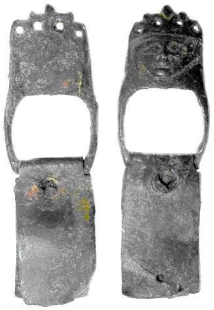 |
|
The folding clasp strap was found by Ron Tansley on a club search.
|
Written by John Gough, Club Librarian |
